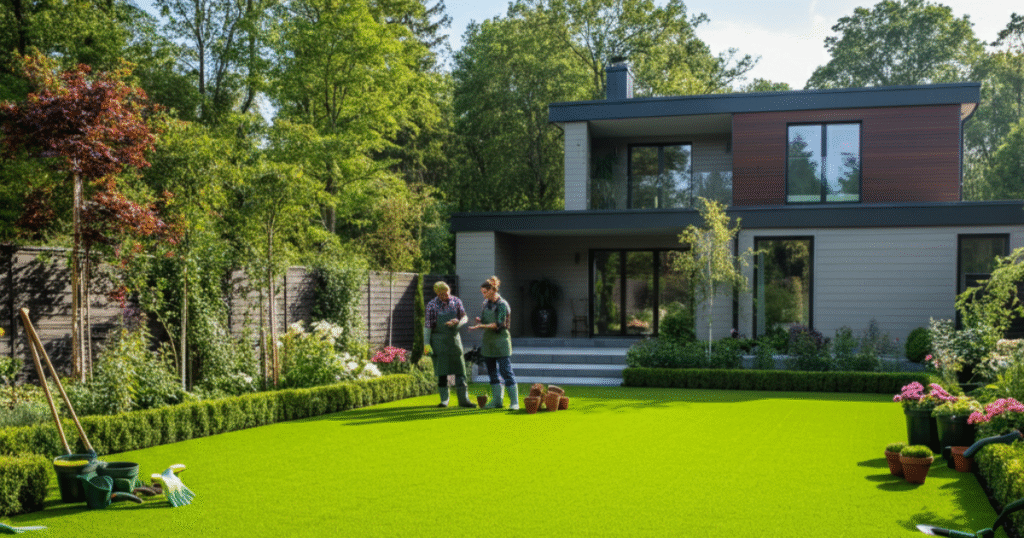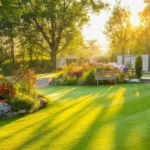Imagine stepping onto a lush, green lawn that stays perfect year-round without the constant watering, mowing, or weeding. That’s the magic of Capital Turf! Whether you’re a landscaper enhancing outdoor spaces, a homeowner dreaming of a low-maintenance lawn, or a gardening enthusiast looking for environmental solutions, Capital Turf has something to offer.
Capital Turf is a high-quality synthetic turf that replicates the look and feel of natural grass. It has gained popularity due to its durability, aesthetic appeal, and sustainability. This guide will walk you through everything you need to know about Capital Turf—from its types and installation steps to maintenance tips and cost comparisons.
Understanding Different Types of Capital Turf
Before choosing Capital Turf for your home or project, it’s important to understand the different options available. Each type is designed to suit specific needs and preferences.
1. Residential Turf
Perfect for homeowners, this type of turf is soft underfoot and designed to mimic the natural look and feel of grass. It’s ideal for front yards, backyards, and patios.
2. Commercial Turf
Durable and heavy-duty, commercial turf is commonly used for large-scale landscaping projects like office complexes, parks, and event venues. It’s built to withstand heavy foot traffic.
3. Sports Turf
Sports enthusiasts will appreciate the design of sports-specific Capital Turf, perfect for soccer fields, golf courses, or tennis courts. Engineered for performance and safety, it features excellent traction and shock absorption.
4. Pet Turf
Pet-friendly turf is designed with pets in mind. It comes with a special drainage system to handle pet waste and remains durable even with rigorous use.
5. Playground Turf
This turf is soft, cushioned, and free from toxic materials, making it safe for children’s play areas.
Step-by-Step Guide on Capital Turf Installation
Installing Capital Turf may seem daunting at first, but it’s a straightforward process when done right. Here’s a step-by-step guide:
1. Prepare the Area
Start by clearing the area of any existing grass, weeds, and debris. Ensure the ground is level and free of obstructions.
2. Lay the Base
Create a solid base using crushed stones or decomposed granite. Compact it with a roller to ensure a firm and even surface.
3. Add a Weed Barrier
Lay down a weed barrier to prevent pesky plants from sprouting underneath your turf.
4. Roll Out the Turf
Unroll your Capital Turf and lay it over your prepared base. Allow it to settle for a day to ensure it flattens out properly.
5. Secure the Edges
Trim the turf to fit the area perfectly and secure the edges with nails or adhesive.
6. Spread and Brush the Infills
Evenly spread sand or rubber infill over the turf. Brush it in using a stiff-bristle broom to ensure an upright, natural look.
7. Final Touches
Hose down the turf to remove any remaining dust, ensuring a fresh, natural look.
Maintenance Tips for a Healthy Capital Turf Lawn
While Capital Turf requires minimal upkeep compared to natural grass, a little care will ensure its longevity and appearance.
- Keep it Clean: Remove leaves, debris, or pet waste regularly. A leaf blower or a gentle rake works perfectly.
- Brush the Turf: Use a stiff broom to fluff the fibers for a natural appearance, especially in high-use areas.
- Spot Rinse: For spills or stains, rinse the affected area with water. Soap and water can help with tougher stains.
- Maintain Drainage: Ensure the drainage system is working well, especially after heavy rain.
Common Problems and Solutions for Capital Turf
Even with its durability, issues can occasionally arise. Here are some common problems that can occur and how to fix them:
- Wrinkling or Buckling: This happens when the base is uneven. Re-level the base and re-lay the turf.
- Odor from Pet Use: Use enzyme-based cleaners to eliminate odors and keep the turf smelling fresh.
- Infills Shifting: Periodically reapply infill to ensure uniform coverage.
Capital Turf vs. Natural Grass: A Comparison
If you’re unsure whether to choose Capital Turf or natural grass, here’s a quick comparison:
|
Feature |
Capital Turf |
Natural Grass |
|---|---|---|
|
Maintenance |
Minimal (no mowing, no watering) |
High (regular mowing, watering) |
|
Aesthetics |
Always green and manicured |
Seasonal variations |
|
Water Usage |
No watering needed |
High water consumption |
|
Longevity |
10–15 years or more |
Dependent on care |
|
Environmental Impact |
No fertilizers or pesticides |
Fertilizers may harm ecosystems |
Cost Analysis of Capital Turf
While the upfront cost of installing Capital Turf is higher than planting grass seeds, the savings over time make it a worthy investment.
- Installation Costs: $5–$20 per square foot, depending on the type of turf.
- Maintenance Costs: Virtually $0 (no mowing, fertilizers, or water bills).
- Payback Period: Most homeowners see a return on investment within 3-5 years.
Showcase of Inspiring Capital Turf Projects
Capital Turf has transformed spaces worldwide. Here are a few examples to inspire your next project:
- Luxury Backyards: Perfectly manicured turf that stays lush even through scorching summers.
- Corporate Offices: Commercial spaces with neat, professional landscapes that impress clients.
- Creative Rooftops: Green rooftop gardens providing a slice of nature in urban areas.
Expert Interviews with Capital Turf Professionals
We spoke with landscaping expert Jill Morgan, who shared some advice for those considering Capital Turf:
“Artificial turf is no longer just a convenience product. It’s an excellent environmental choice that saves water while still providing the aesthetics of natural grass. With proper installation and upkeep, it lasts for years!”
Why Capital Turf is a Smart Choice
Capital Turf offers the perfect blend of beauty, practicality, and sustainability. Its minimal maintenance, long-term cost savings, and environmental benefits make it an obvious choice for homeowners, landscapers, and gardening enthusiasts.
If you’re ready to transform your outdoor space and enjoy the perks of a flawless lawn year-round, Capital Turf is the way to go.





